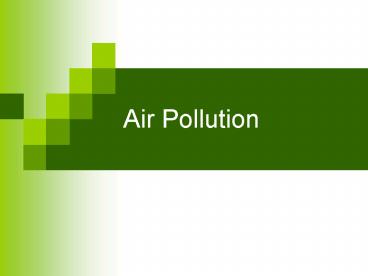Air Pollution - PowerPoint PPT Presentation
1 / 34
Title: Air Pollution
1
Air Pollution
2
The atmosphere is the gaseous envelope that
surrounds the earth and constitutes the
transition between its surface and the vacuum of
space.
Temperatures in the thermosphere go up when
moving farther away from ground level due to the
sun's energy.
Temperatures are warmest at the lowest level of
the mesosphere and coldest at its highest level
Ozone Layer is here and it protects us from the
Suns UV-rays
People, plants, animals, and insects live here.
It is the layer where all weather occurs.
3
Composition of Troposphere
Air Pollution
Air Pollution is the human introduction into the
air of chemicals, particulates, or biological
materials that cause harm or discomfort to humans
or other living organisms, or damage the
environment.
Primary pollutants are substances directly
emitted from a process, such as ash from a
volcanic eruption or the carbon monoxide gas from
a motor vehicle exhaust.
Secondary pollutants are not emitted directly.
Rather, they form in the air when primary
pollutants react or interact with air molecules.
4
Air Pollution Sources Movement
- Smokestacks-emissions released from power plant
are carried away by air currents (winds),
temperature, pressure, and other factors located
in the troposphere - Taller smokestacks allow emissions to spread out
and be less concentrated - Plumes-path that pollution takes through the air
- Size and shape of plumes can enable scientist to
understand how they move
5
Particulates
- Particulates are extremely tiny, even
microscopic, bits of ash and dust. - Particulates can be sulfates (acidic forms of
sulfur that can damage lungs), traces of heavy
metals (such as lead, cadmium, and nickel), and
unburned hydrocarbon compounds (VOCS, such as
benzene and ethylene). - Large particulates generally settle in the mouth
or nose. They cause asthma attacks and other
respiratory problems. - Fine particulates are the most serious danger to
health. They cause lung disease. - Coal-burning power plants account for more than
23 of all particulates emitted into the air.
6
Mercury Bioaccumulation
7
Carbon Cycle
8
OZONE
9
Ozone Formation in Stratosphere
Ozone layer protects us from the UV-B rays from
the sun.
10
Ozone Depletion
11
Chlorofluorocarbons (CFCs)
- Chlorofluorocarbons, or CFCs, were developed in
the 1930s. - CFCs are made up of carbon, chlorine and fluorine
atoms and there are a number of different types. - CFCs are widely used as
- solvents in cleaners
- coolants in refrigeration and air
conditioning - blowing agents in the production of foam
- propellants in aerosols.
- CFCs have a lifetime of about 20100 years and
can therefore continue to destroy ozone for a
long period. - One CFC molecule can result in the loss of
100,000 ozone molecules.
12
OZONE Thinning
13
Effects
Skin Cancer
Cataracts-eye lens cloud up and blurs vision and
cause blindness
UV rays kill phytoplankton near the surface of
ocean and disrupts ocean food chain.
14
Montreal Protocol
- The Montreal Protocol on Substances That
Deplete the Ozone Layer international treaty
designed to protect the ozone layer by phasing
out the production CFCs
15
(No Transcript)
16
Smog
17
What IS smog?
- 3 ingredients
- NO2 (yellowish-brown gas)
- O3 (Ozone)
- VOCs (volatile organic compounds)
- VOCs released when fossil fuels not completely
burned - Ozone forms at ground level when NO2 is split up
by UV rays and joins with O2
18
The Dark Side of Ozone
- O3 protects us from UV rays in the stratosphere,
but - Causes breathing and other health problems at
ground level - Reason for ozone action days in summer weather
conditions make it easy for smog to form - Reduce car travel, electricity use in order to
reduce amount of NOx O3
19
Acid Rain
20
pH Scale
21
- Nitrogen oxides (NOx) and sulfur oxides (SOx)
generated in the burning of fossil fuels - React in the atmosphere to produce nitric (HNO3)
and sulfuric acid (H2SO4) - Dissolve in rain to become acid rain
22
(No Transcript)
23
Effects
- Causes building materials to corrode.
- Fish aquatic insects sensitive to changes in
pH. Causes death disruption of food chains. - Minerals (K, Mg2, Ca2) leached from soil,
making soil less fertile
24
Prevention
Scrubber
Electrostatic Precipitator
25
Global Warming
26
GREENHOUSE EFFECT
27
GREENHOUSE GASES
- Water vapor is the most important, but is
variable and hard to determine if we impact
directly. - Carbon dioxide is the largest of the manufactured
gases, mostly from burning fossil fuels. - Methane from the anaerobic breakdown of organic
matter in landfills. - Nitrous Oxide (N2O) from smog and nylon
production, burning coal and biomass - CFCs-man-made coolant
28
Global Warming
- Prediction Earths temperature will increase by
1oC-3.5oC by the year 2050. - CO2 has been steadily increasing over the last 40
years many scientists believe that global
warming is occurring due to increased amounts of
this gas. - Realize that a 1ºC increase would make the planet
hotter than it has been in 10,000 years
29
Keeling Curve
30
Global Temperature Change
Past Climate Change
Recent trends in global temperatures
31
Some Possible Effects of a Warmer World
32
Effects
33
Solutions Dealing with the Threat of Climate
Change
34
What has been done to Reduce Greenhouse Gas
Emissions?
- 1992 Earth Summit in Rio de Janeiro
- 106 developed nations committed to reduce
greenhouse gases to 1990 levels by the year 2000.
- Most countries did not achieve this goal.
- 1997 Kyoto Treaty
- Signed by 161 nations. Developed countries will
cut greenhouse emissions. Developing countries
are exempt. - By 2009, US has not ratified treaty
- Also, the coal, oil, steel, chemical and
automobile companies opposed treaty because it
would be devastating to the economy and workers.































